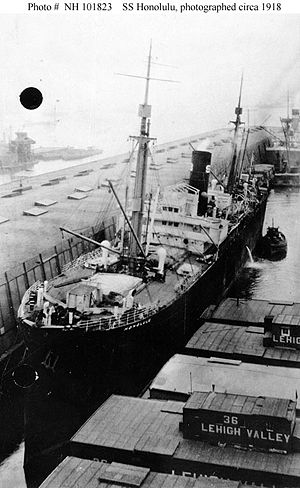USS Honolulu (ID-1843)
| |
This article is an orphan, as few or no other articles link to it. Please introduce links to this page from related articles; suggestions are available. (February 2009) |
 SS Honolulu ca. 1918, prior to her U.S. Navy service as USS Honolulu | |
| Career (United States) | 100x35px |
|---|---|
| Name: | USS Honolulu |
| Namesake: | Honolulu, capital city of what was then the Territory of Hawaii (previous name retained) |
| Builder: | Armstrong Whitworth Ltd., Newcastle, England |
| Completed: | 1905 |
| Acquired: |
12 June 1917 by U.S. Government Possibly July 1918 by U.S. Navy |
| Commissioned: | Possibly 26 July 1918 |
| Decommissioned: | Possibly March 1919 |
| Fate: |
Returned to United States Shipping Board Sold 26 January 1920 |
| Notes: |
In commercial service as SS Setos and SS Itasca 1905-1917 iIn Shipping Board custody and United States Army service as SS Honolulu 1917-1918 In commercial service as SS Honolulu and SS Commercial Trader from 1920 |
| General characteristics | |
| Type: | Cargo ship |
| Displacement: | 4,902 tons |
| Length: | 412 ft 0 in (125.58 m) |
| Beam: | 51 ft 0 in (15.54 m) |
| Draft: | 25 ft 3 in (7.70 m) mean |
| Speed: | 12 knots |
| Armament: |
1 x 5-inch (127-millimeter) gun 1 x 3-inch (76.2-millimeter) gun |
The first USS Honolulu (ID-1843) was a cargo ship that served in the United States Navy probably from 1918 to 1919.
Honolulu was built as SS Itasca by Armstrong Whitworth Ltd., Newcastle, England, England, in 1905. She was taken over by the United States for World War I on 12 June 1917, transferred to United States Shipping Board ownership and assigned to United States Army service. Although she operated as a U.S. cargo transport with a U.S. Navy crew, there is no record of her commissioning. Her name was changed to Honolulu on 26 July 1918[1].
Honolulu's service included cargo cruises between the United States and various French ports.
U.S. Navy personnel were released from the ship in March 1919[2] and she was rejected for further U.S. Navy service on 2 April 1919. Honolulu was returned to the United States Shipping Board and sold on 26 January 1920.
Honolulu resumed commercial service, and her name later was changed to Commercial Trader.
Notes
- ↑ This may reflect a commissioning date; many U.S. Navy World War I cargo ships were commissioned in 1918 aftyer 1917-1918 U.S. Army service, and a commissioning date is a logical date on which her name would change.
- ↑ This may reflect her decommissioning, as that is a logical time for U.S. Navy personnel to depart.
References
- This article includes text from the public domain Dictionary of American Naval Fighting Ships. The entry can be found here.
External links
- Orphaned articles from February 2009
- Articles with invalid date parameter in template
- All orphaned articles
- Pages with broken file links
- Wikipedia articles incorporating text from the Dictionary of American Naval Fighting Ships
- World War I cargo ships of the United States
- United States Navy Hawaii-related ships
- Tyne-built ships
- 1905 ships
- Unique cargo ships of the United States Navy
